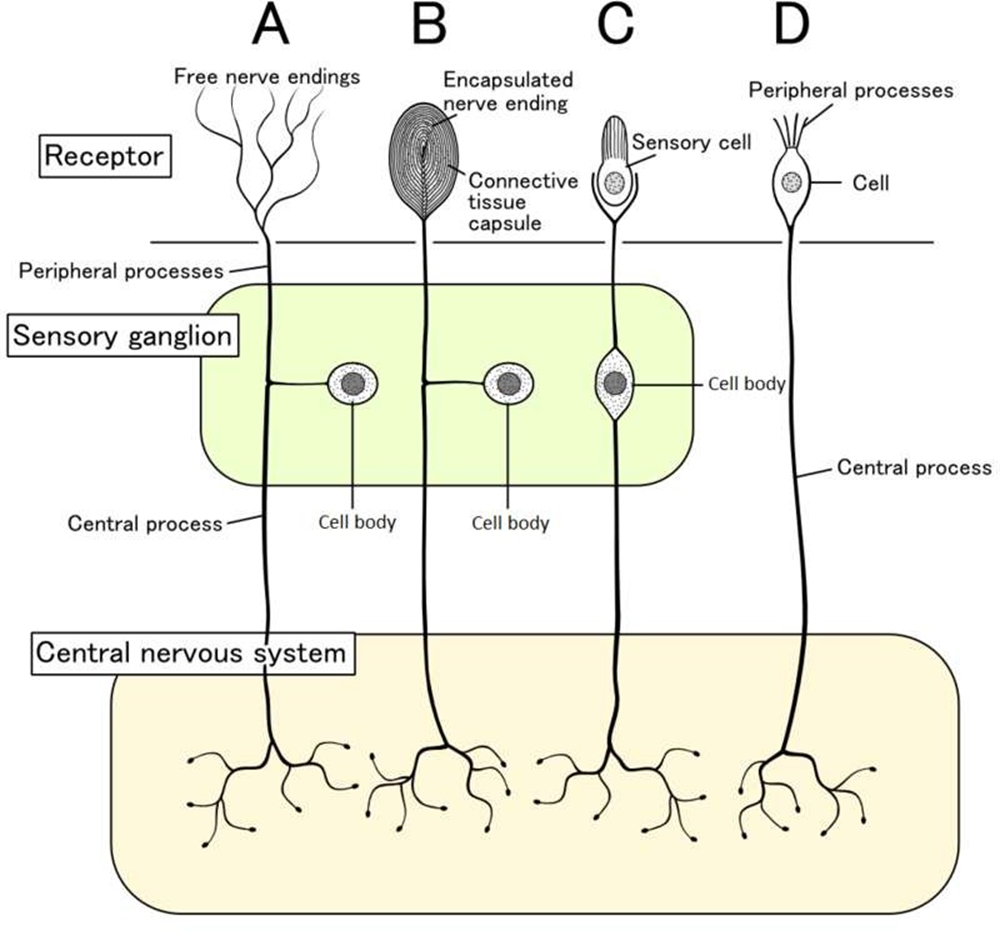What triggers the afferent pathways, resulting in the sensation of pain?
Spinal cord
Nociceptors
Endorphins
Cortex
The Correct Answer is B
Choice A rationale:
The spinal cord plays a crucial role in pain transmission, but it does not initiate the afferent pathways. It receives pain signals from nociceptors and relays them to the brain for processing.
The spinal cord is also involved in pain modulation, as it can dampen or amplify pain signals depending on various factors. However, it is not the primary trigger for pain sensation. That role belongs to nociceptors.
Choice B rationale:
Nociceptors are specialized sensory receptors that detect potentially damaging stimuli, such as intense heat, pressure, or chemical irritants.
They are located throughout the body, including the skin, muscles, joints, and internal organs.
When nociceptors are activated, they generate electrical signals that travel along nerve fibers to the spinal cord and brain. This process initiates the afferent pathways, which ultimately lead to the conscious perception of pain.
Nociceptors are essential for protecting the body from harm. They alert us to potential dangers and trigger responses that help us avoid injury or further damage.

Choice C rationale:
Endorphins are natural pain-relieving substances produced by the body. They act on receptors in the brain and spinal cord to reduce pain perception.
However, endorphins do not trigger the afferent pathways. They work by modulating pain signals that have already been initiated by nociceptors.
Choice D rationale:
The cortex is the outer layer of the brain that is responsible for higher-level functions, such as thinking, feeling, and decision- making.
It plays a role in the conscious experience of pain, but it does not trigger the afferent pathways.
The cortex receives pain signals from the spinal cord and processes them, leading to the awareness of pain.
Nursing Test Bank
Naxlex Comprehensive Predictor Exams
Related Questions
Correct Answer is B
Explanation
Choice A rationale:
Removing the tube immediately upon patient gagging is not the most appropriate first step. Gagging is a common reflex during nasogastric tube insertion and can often be managed without removing the tube.
Premature removal could lead to unnecessary discomfort for the patient and potential delays in treatment.
The nurse should attempt to reposition the tube or have the patient sip water to facilitate passage before considering removal.
Choice B rationale:
Tucking the chin to the chest and swallowing are essential maneuvers that help guide the tube into the esophagus and reduce the risk of misplacement into the trachea.
These actions close off the airway and open the esophagus, creating a smoother path for the tube.
The nurse should instruct the patient to perform these actions during insertion to promote successful placement.
Choice C rationale:
While a supine position is often used for nasogastric tube insertion, it is not the most crucial factor for success.
Studies have shown that a high-Fowler's position (sitting upright with head elevated) may be equally effective and potentially more comfortable for patients.
The nurse should consider patient comfort and potential contraindications (such as respiratory distress) when choosing the most appropriate position.
Choice D rationale:
Measuring the tube from the nose tip to the navel is an outdated practice that can lead to inaccurate placement. The correct measurement is from the nose tip to the earlobe to the xiphoid process (NEX).
This landmark-based method provides a more reliable estimation of the distance to the stomach.
Correct Answer is D
Explanation
NPO status (nothing by mouth) is not a relevant intervention in this situation. It would be indicated for a patient with gastrointestinal issues or prior to a procedure, but it does not address the potential consequences of rapid fluid administration.
Restricting oral intake would not reverse or mitigate the effects of fluid overload that may have already occurred.
It's important to prioritize assessment of the patient's respiratory status, as fluid overload can lead to pulmonary edema, a serious complication.
Rationale for Choice B:
Elevating the head of the bed to high Fowler's position can be helpful in easing breathing for patients with respiratory distress, but it's not the most immediate priority in this case.
Assessing the patient's respiratory status directly through respiratory rate and lung sounds will provide more comprehensive information about potential fluid overload and guide further interventions.
Rationale for Choice C:
Measuring the client's temperature is not directly relevant to the concern of rapid fluid administration.
While fever could be a sign of infection, which might warrant fluid administration, it's not the primary concern in this scenario.
The priority is to assess for potential fluid overload, which could manifest as respiratory distress. Rationale for Choice D:
Checking the client's respiratory rate and lung sounds is the most appropriate action for the nurse to take in this situation.
Rapid infusion of 900 mL of fluid within a short period could lead to fluid overload, which can manifest as: Increased respiratory rate
Crackles in the lungs Shortness of breath Hypoxia
Early identification of these signs is crucial for prompt intervention and prevention of serious complications.
Whether you are a student looking to ace your exams or a practicing nurse seeking to enhance your expertise , our nursing education contents will empower you with the confidence and competence to make a difference in the lives of patients and become a respected leader in the healthcare field.
Visit Naxlex, invest in your future and unlock endless possibilities with our unparalleled nursing education contents today
Report Wrong Answer on the Current Question
Do you disagree with the answer? If yes, what is your expected answer? Explain.
Kindly be descriptive with the issue you are facing.
